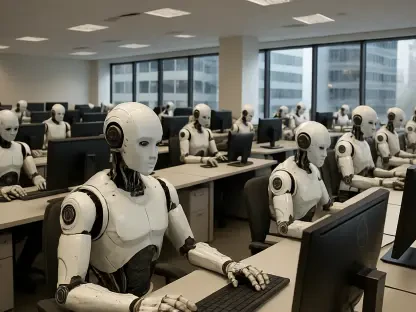Sofia Khaira is an acclaimed expert in diversity, equity, and inclusion, with a passionate drive to help businesses develop inclusive work environments. With her extensive background in human resources, Sofia is instrumental in fostering equitable talent management. In this interview, we delve into the critical yet often overlooked topic of AI’s environmental impact and how HR can take a lead in addressing this issue.
How significant is the current demand for AI, and how does this demand impact electricity consumption globally?
The demand for AI has skyrocketed, fueled by its wide-ranging applications from personal assistants to complex data analytics. This surge in AI utilization has a profound impact on global electricity consumption. Training AI models, particularly large ones like those created by OpenAI, requires immense computational power, translating to substantial energy use. For example, training the ChatGPT-4 model consumed enough electricity to power approximately 20,000 UK homes for a year. As AI integration expands, this significant power consumption will continue to grow, posing serious environmental challenges.
Can you explain the differences in power consumption between traditional data centers and AI data centers?
Traditional data centers primarily handle storage and straightforward computations, which are less power-intensive. In contrast, AI data centers are designed to manage complex computations and vast datasets required for training and operating AI models. This means they consume dramatically more power—estimated to be six to ten times more than traditional data centers. These centers are, therefore, a heavy strain on power resources, necessitating more robust and sometimes fossil-fuel-based power solutions to meet their high energy demands.
How do AI data centers impact local power grids and fossil fuel usage?
The immense power needs of AI data centers strain local power grids and can lead to significant reliance on fossil fuels. In many cases, to ensure these centers receive sufficient power, there’s either a delay in phasing out fossil fuel plants or even a revival of decommissioned ones. This increase in fossil fuel use negates some of the progress towards clean energy transitions and exacerbates the environmental footprint of these facilities. Additionally, the infrastructure around these centers, such as cooling systems, can drain local resources like water, further impacting the local environment.
What are the energy requirements to train advanced AI models like ChatGPT-4?
Training an advanced AI model like ChatGPT-4 is energetically intensive. The process can consume tens of thousands of megawatt-hours of electricity over a period of months. This high energy requirement is due to the complex and iterative nature of training deep learning models, which involves running numerous calculations on a large scale. Such heavy resource consumption underscores the need for developing more energy-efficient AI training methodologies.
How does the electricity usage of everyday AI tasks, like Google searches or image generation, compare to other common tasks?
Everyday AI tasks consume more electricity than most users might expect. For instance, a single Google search uses enough electricity to power a 60W lightbulb for 17 seconds, while running a query on models like ChatGPT-4 could power that same lightbulb for several minutes. Moreover, generating images via AI consumes even more, lighting a 60W bulb for anywhere from 85 minutes to seven hours. These comparisons illustrate just how energy-demanding AI operations can be in contrast to other digital activities.
Why is there so little public discussion about AI’s environmental impact?
The public discourse heavily focuses on the benefits and advancements AI brings, often sidelining its environmental costs. This lack of discussion stems from an initial phase where companies seek to capitalize on AI’s market potential without immediately addressing its ecological footprint. AI’s association with innovation and increased productivity tends to overshadow the less glamorous aspects of its environmental impact, making it a less popular topic for widespread discussion.
How do big AI suppliers balance market competition with their public pledges towards decarbonization?
Balancing market competition with decarbonization pledges is a significant challenge for major AI suppliers. Companies like Google and Microsoft are constantly expanding their data center capacities to maintain competitive edges, often leading to increased emissions. Despite publicly committing to decarbonization, these firms face a dilemma where rapid growth can counteract their sustainability goals. To truly balance these aspects, companies need to integrate sustainability more deeply into their growth strategies and invest in green technologies.
With the growing awareness of AI’s impact, how can organizations mitigate these ecological effects?
Organizations can take several steps to mitigate the ecological impacts of AI. One approach is to invest in more energy-efficient hardware and optimize their existing infrastructure to reduce overall power consumption. Implementing more renewable energy sources to power data centers is crucial. Additionally, companies should focus on developing and applying AI technologies that enhance operational efficiencies and reduce waste. Collaborative efforts with stakeholders and continuous monitoring of their carbon footprint can also lead to more sustainable AI practices.
Why should HR leaders be concerned about the environmental impact of AI within their organizations?
HR leaders are central to shaping company culture and policy, making their role crucial in addressing AI’s environmental impact. As organizations increasingly adopt AI technologies, HR must ensure that these advancements align with the company’s sustainability goals. By understanding AI’s ecological footprint, HR can advocate for responsible use, promote awareness among employees, and integrate sustainability into talent management practices, reinforcing the organization’s commitment to environmental stewardship.
How can HR contribute to addressing AI-related energy concerns within organizational operations?
HR can spearhead initiatives to address AI-related energy concerns by fostering a culture of sustainability. This can involve training employees on the environmental impacts of AI and encouraging best practices to minimize energy use. HR can also work with IT and operations teams to adopt energy-efficient technologies and implement policies that support eco-friendly practices. By aligning HR strategies with sustainability goals, HR leaders can help the organization reduce its overall carbon footprint while leveraging AI technologies.
What is the significance of Scope 3 emissions, and how do they relate to AI and digital infrastructure?
Scope 3 emissions are indirect emissions that occur across a company’s value chain, including those from the use of products and services purchased. For AI and digital infrastructure, these emissions can originate from the energy used by data centers and the production and disposal of hardware. Given that these indirect emissions often account for a significant portion of a company’s total carbon footprint, addressing them is vital for comprehensive decarbonization efforts.
How can HR departments engage with suppliers to minimize Scope 3 emissions effectively?
HR departments can play a pivotal role by fostering strong relationships with suppliers and setting clear sustainability expectations. Incorporating sustainability criteria into procurement processes ensures that suppliers are committed to reducing their carbon footprints. HR can also drive collaborations for shared sustainability goals, offer training on green practices, and regularly audit supplier performance to ensure compliance. Engaging suppliers in this manner not only minimizes Scope 3 emissions but also promotes a culture of sustainability throughout the supply chain.
What steps should HR take to educate and align their workforce on the sustainability impacts of AI?
HR should develop comprehensive training programs to educate employees on the environmental impacts of AI. This includes providing resources on energy-efficient practices, the importance of reducing carbon footprints, and the role of AI in sustainability efforts. Incorporating these topics into corporate values and embedding them in performance appraisals can further reinforce their importance. Consistent communication and engagement initiatives can help align the workforce with the organization’s sustainability goals.
How can HR develop strategic capabilities to integrate AI and sustainability into the broader organizational goals?
HR can develop strategic capabilities by fostering interdisciplinary collaboration and investing in continuous education. This involves staying abreast of the latest trends in AI and sustainability and understanding their implications for business operations. HR can also implement policies to support innovation in sustainable practices, advocate for the use of AI in efficient resource management, and ensure that sustainability metrics are integrated into overall business strategies.
What role does collaboration with suppliers and external partners play in achieving sustainability goals concerning AI?
Collaboration with suppliers and external partners is essential for achieving sustainability goals related to AI. By working together, organizations can share best practices, innovate collectively, and establish industry standards for reducing environmental impacts. Strong partnerships can lead to the development of more sustainable technologies and processes, fostering a collaborative ecosystem that prioritizes and supports environmental responsibility.
Can you provide examples of successful collaborations that have helped organizations meet their sustainability targets?
Several companies have successfully collaborated to meet sustainability targets. For instance, partnerships between tech firms and renewable energy providers have led to data centers powered by green energy, significantly reducing carbon footprints. Another example is companies collaborating with suppliers to develop eco-friendly packaging or energy-efficient hardware. These successful collaborations highlight the potential for shared innovation and concerted efforts in achieving ambitious sustainability objectives.
How will AI and sustainability considerations shape the future of work?
AI and sustainability considerations will profoundly reshape the future of work. AI will automate routine tasks, creating opportunities for higher-level, strategic roles focused on innovation and ethical considerations. Sustainability will become integral to business strategies, influencing job roles, organizational structures, and workplace cultures. As businesses prioritize environmentally responsible practices, we will see a rise in green jobs and the integration of sustainability metrics into performance evaluations and company objectives.
What new roles and skills will be essential as organizations increasingly adopt AI technologies?
As organizations embrace AI, new roles such as AI ethics officers, sustainability analysts, and digital transformation leads will become essential. Skills in data analysis, machine learning, and sustainability management will be in high demand. Additionally, employees will need soft skills like adaptability, critical thinking, and collaboration to navigate the evolving landscape. Continuous learning and development will be crucial to equip the workforce with the necessary capabilities to thrive in an AI-driven, sustainability-focused environment.
Why is it critical for HR to elevate its role in strategic discussions about AI and sustainability?
HR’s involvement in strategic discussions about AI and sustainability is crucial because these areas significantly impact organizational dynamics and culture. HR can ensure that the adoption of AI aligns with ethical standards and sustainability goals while fostering a workforce that is adaptable and resilient to change. By participating in these discussions, HR can advocate for policies and practices that promote long-term value, drive engagement, and enhance the company’s reputation as a socially responsible entity.
Do you have any advice for our readers?
For HR leaders and professionals, staying informed and proactive is key. Embrace the intersection of AI and sustainability as an opportunity to lead meaningful change within your organizations. Foster a culture of continuous learning, and engage employees at all levels in conversations about environmental responsibility. By aligning your HR strategies with broader sustainability goals, you can position your organization for long-term success while making a positive impact on the planet.









